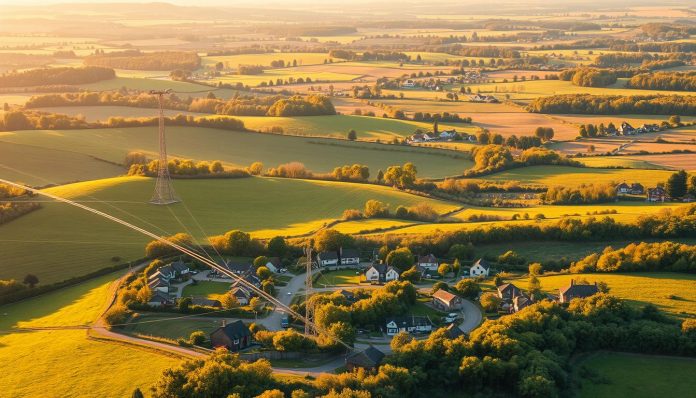More than 113,000 premises were passed between April and December 2024, a striking figure that shows the scale of the national effort to upgrade connectivity in the countryside.
In year one, delivery partners such as CityFibre and Quickline began visible builds from Grantchester to Yorkshire and Lincolnshire. Project Gigabit, the government-backed programme, reached 1.19 million premises through public funding and set a target of full coverage by 2030.
On the ground, households and local businesses started to feel the benefits: faster broadband, better home working, smoother streaming, and new digital opportunities for schools and firms. A community fund and ESG links with STEM Learning and The Wildlife Trust aim to tackle digital exclusion alongside infrastructure work.
Key Takeaways
- The news marks a clear milestone in a major government programme.
- Over 113,000 premises were passed in a recent nine‑month snapshot.
- CityFibre and Quickline feature as principal delivery partners on the ground.
- Public funding has reached more than 1.19 million premises so far.
- Early benefits include improved work, education and local business productivity.
A new digital horizon for rural Britain
Initial builds brought real links to community hubs, so people could finally rely on steady online access at home.
What changed in year one was not just a faster connection but a shift in daily life. Tens of thousands of additional premises were passed between April and December 2024, and public funding reached 1.19 million premises. That progress pushed gigabit-capable coverage beyond four-fifths of the country.
Practical gains arrived quickly. Homes saw smoother streaming and fewer dropped video calls. Local businesses began planning digital services with greater confidence.
- Coverage and access rose, reducing barriers to online education and public services.
- Community funds and partnerships with STEM Learning and The Wildlife Trust supported inclusion.
- Better connectivity unlocked new opportunities for flexible work and small enterprises.
| Area | Impact | Indicator | Lead partner |
|---|---|---|---|
| Homes | Stable streaming & remote working | 113,000 premises passed (Apr–Dec 2024) | CityFibre (Grantchester) |
| Communities | Digital inclusion & skills | 1.19 million premises reached | BDUK & delivery partners |
UK’s Project Gigabit Marks One-Year Milestone: How It’s Changing Rural Life
Year one of the national rollout delivered visible progress in towns and villages from Cambridgeshire to Lincolnshire.
The project at a glance summarises key figures and the aims behind the work. Public funding has reached 1.19 million premises, while more than 113,000 premises were passed between April and December 2024. Over 85% of the UK can now access gigabit speed as the programme heads towards full coverage by 2030.
The project at a glance: key figures, coverage, and objectives
The objective is simple: close the digital divide by scaling gigabit‑capable coverage. Delivery mixes public contracts, local vouchers, and legacy schemes to match varied geographies and engineering constraints.
On‑the‑ground delivery: CityFibre and Quickline
CityFibre marked a year in Cambridgeshire, starting in Grantchester and supporting homes and businesses with reliable broadband and community initiatives.
Quickline secured private backing and Project Gigabit subsidies to extend full fibre to roughly 360,000 additional premises, targeting hard‑to‑reach parts of Yorkshire and Lincolnshire and densifying the local network.
| Metric | Figure | Notes |
|---|---|---|
| Premises reached (public funding) | 1.19 million | Combined government and delivery partner activity |
| Premises passed (Apr–Dec 2024) | 113,000+ | Eight‑month snapshot of rollout momentum |
| Planned Quickline expansion | 360,000 premises | Backed by £250m from private funds |
| Coverage | 85%+ | Progress en route to 2030 full coverage target |
- Investment combined public and private capital to reach areas with weak commercial cases.
- Named communities from Escrick to North Cave show tangible local impact.
- The approach uses full fibre as long‑term infrastructure for homes and businesses.
The real-world impact: more than just speed
The upgrades have delivered practical change across towns and villages. CityFibre’s community funds and partnerships with STEM Learning and The Wildlife Trust targeted digital exclusion. These schemes supported skills training, device access, and local events so people could use services, not just enjoy faster connections.

Community benefits: tackling digital exclusion and strengthening local networks
Communities saw targeted support that built confidence online. Funds helped schools, libraries and community hubs give people the tools to take part in digital life.
Improved remote work and education: reliable broadband for homes and businesses
Upgrades made remote work viable for sole traders and professionals. Firms reported fewer dropped calls and smoother cloud collaboration, while homes accessed education platforms with far less disruption.
Enhanced quality of life: everyday reliability, streaming, and smart services
Dependable broadband cut interruptions for streaming and smart home services. Families found online learning, entertainment, and energy management easier to manage.
Economic development: investment, premises passed, and opportunities for rural enterprises
Quickline named places such as Escrick, Barnby Dun, and North Cave among early beneficiaries, with construction continuing in many villages and a target to reach around 200,000 rural premises by year‑end.
- Local businesses adopted online bookings, e‑commerce, and digital payments as network stability improved.
- Investment boosted confidence, creating opportunities for agri‑tech, tourism, and creative industries.
- Overall progress reinforced the case for more full-fibre and wider access across the economy.
The broader context: why full-fibre matters
Policy shifts and targeted funding have placed full‑fibre at the centre of long‑term infrastructure aims.
From strategy to delivery, BDUK data and SRN progress show a movement from building towards outcomes. The SRN reached 95% 4G geographic coverage a year early, while the programme passed more than 113,000 premises between April and December 2024 and has reached 1.19 million to date.
From rollout to outcomes: aligning data and strategy
Full fibre underpins reliable broadband and supports wireless backhaul. The 10‑Year Infrastructure Strategy and Industrial Strategy elevated digital networks as strategic assets.
“Targeted investments can extend fibre where market forces alone would not.”
- Blended delivery—contracts, vouchers, and legacy schemes—helped different areas respond to terrain and cost.
- SRN gains complemented fixed network upgrades, but true coverage requires focused work on remaining not‑spots.
- Targeted awards, such as the £157m Highlands and Islands contract, show how spending reaches the hardest parts.
| Metric | Effect | Lead |
|---|---|---|
| 4G coverage | 95% achieved early | SRN |
| Premises reached | 1.19 million | BDUK & partners |
| Strategic funding | Reduced barriers | Government |
Conclusion: a template for the rest of the UK
The first year showed a practical blueprint that other areas can follow. CityFibre’s work in Cambridgeshire and Quickline’s funded expansion into Yorkshire and Lincolnshire proved that coordinated public funding and private capital can reach hard‑to‑serve places and deliver full fibre at scale.
The government project combined engineering, community investment, and clear governance to produce real benefits for homes and businesses. Measured results — 1.19 million premises reached and over 85% gigabit availability — show the model works for people and local economies.
Replicating this approach will need steady policy, accurate data, and aligned infrastructure planning. Continued government and industry collaboration can turn rollout momentum into durable connectivity and a lasting opportunity for the whole country.
For more articles on Telecommunications, please follow the link


